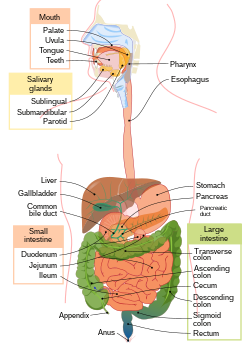Accessory pigments are light-absorbing compounds, found in photosynthetic organisms, that work in conjunction with chlorophyll a. They include other forms...
4 KB (514 words) - 10:02, 11 February 2024
A photosynthetic pigment (accessory pigment; chloroplast pigment; antenna pigment) is a pigment that is present in chloroplasts or photosynthetic bacteria...
4 KB (406 words) - 05:48, 24 June 2024
Fucoxanthin is a xanthophyll, with formula C42H58O6. It is found as an accessory pigment in the chloroplasts of brown algae and most other heterokonts, giving...
8 KB (754 words) - 13:28, 9 May 2025
Chlorophyll a (category Photosynthetic pigments)
the only pigment that can be used for photosynthesis. All oxygenic photosynthetic organisms use chlorophyll a, but differ in accessory pigments like chlorophyll...
19 KB (1,559 words) - 08:47, 25 May 2025
process of photosynthesis, they have functions in light-harvesting (as accessory pigments), in photoprotection (energy dissipation via non-photochemical quenching...
33 KB (3,911 words) - 15:47, 23 May 2025
"yellow") is a bright yellow accessory pigment found in many organisms that perform photosynthesis. It is a xanthophyll cycle pigment, an oil-soluble alcohol...
10 KB (854 words) - 19:52, 22 May 2025
an increase in photosynthetic pigments. Though not absolute proof, these findings do implicate MAAs as accessory pigments to photosynthesis. The eyes for...
27 KB (2,864 words) - 01:37, 24 May 2025
Chlorophyll c (category Photosynthetic pigments)
commonly found in algae and plants. It has a blue-green color and is an accessory pigment, particularly significant in its absorption of light in the 447–520 nm...
11 KB (693 words) - 20:57, 27 May 2025
Phycoerythrin (category Photosynthetic pigments)
red protein-pigment complex from the light-harvesting phycobiliprotein family, present in cyanobacteria, red algae and cryptophytes, accessory to the main...
22 KB (2,010 words) - 12:18, 23 May 2025
photosynthesis. The photosynthetic action spectrum depends on the type of accessory pigments present. For example, in green plants, the action spectrum resembles...
110 KB (11,833 words) - 06:46, 29 May 2025
Phycocyanin (category Photosynthetic pigments)
pigment-protein complex from the light-harvesting phycobiliprotein family, along with allophycocyanin and phycoerythrin. It is an accessory pigment to...
33 KB (3,808 words) - 13:42, 22 April 2025
plant pigment, is most efficient in capturing red and blue light. Accessory pigments such as carotenes and xanthophylls harvest some green light and pass...
20 KB (2,687 words) - 10:08, 28 October 2024
d, as well as accessory pigments such as phycobilin pigments and xanthophylls. Depending on the relative proportions of these pigments and the light conditions...
16 KB (1,438 words) - 20:00, 9 March 2024
Plant physiology (section Pigments)
Carotenoids are red, orange, or yellow tetraterpenoids. They function as accessory pigments in plants, helping to fuel photosynthesis by gathering wavelengths...
30 KB (3,553 words) - 01:22, 9 January 2025
Chloroplast (redirect from Chloroplast pigment)
blue-green pigment partially responsible for giving most cyanobacteria and chloroplasts their color. Other forms of chlorophyll exist, such as the accessory pigments...
193 KB (19,591 words) - 13:51, 22 May 2025
surface due to the presence of chlorophyll within their cells and accessory pigments (such as phycobiliproteins or xanthophylls) in some species. Phytoplankton...
68 KB (7,037 words) - 17:55, 22 May 2025
reticulum or unstacked (stroma) thylakoids, and use phycobiliproteins as accessory pigments, which give them their red color. Despite their name, red algae can...
63 KB (6,312 words) - 21:18, 22 May 2025
Synechococcus (section Pigments)
was later subdivided into subgroups based on the presence of the accessory pigment phycoerythrin. The marine forms of Synechococcus are coccoid cells...
31 KB (3,393 words) - 13:49, 26 May 2025
Chlorophyll (category Photosynthetic pigments)
Besides chlorophyll a, there are other pigments, called accessory pigments, which occur in these pigment–protein antenna complexes. Several chlorophylls are...
37 KB (3,755 words) - 16:55, 23 May 2025
Process of tattooing (section Dyes and pigments)
machine and often procedures and accessories to reduce the risk to human health. Tattooing involves the placement of pigment into the skin's dermis, the layer...
29 KB (3,498 words) - 05:42, 18 May 2025
Human digestive system (redirect from Accessory digestive organ)
human digestive system consists of the gastrointestinal tract plus the accessory organs of digestion (the tongue, salivary glands, pancreas, liver, and...
68 KB (8,936 words) - 11:46, 11 May 2025
essential components as accessory pigments for the light-harvesting reaction centers. Xanthophylls are another group of tetraterpene pigments distributed widely...
3 KB (341 words) - 23:42, 14 August 2023
Orpiment (redirect from Chinese Yellow (pigment))
takes its name from the Latin auripigmentum (aurum, "gold" + pigmentum, "pigment"), due to its deep-yellow color. Orpiment once was widely used in artworks...
19 KB (1,794 words) - 16:15, 24 May 2025
photosynthetic pigments in the organism. Chlorophylls absorb light in the violet-blue and red parts of the spectrum, while accessory pigments capture other...
20 KB (2,491 words) - 16:06, 23 May 2025
Allophycocyanin (category Photosynthetic pigments)
with phycocyanin, phycoerythrin and phycoerythrocyanin. It is an accessory pigment to chlorophyll. All phycobiliproteins are water-soluble and therefore...
4 KB (427 words) - 19:16, 23 January 2024
encrustations may result in reduced concentrations of the primary and accessory pigments in the kelp blade tissue. "Coffin Box Bryozoan". Fisheries and Oceans...
9 KB (1,031 words) - 01:11, 18 October 2024
Some plants have leaves of different colours due to the presence of accessory pigments such as carotenoids in their mesophyll cells. The veins are the vascular...
114 KB (11,815 words) - 07:43, 28 May 2025
Cryptomonas is distinguished by the purple phycoerythrin 566 as an accessory pigment, which gives the organisms a brownish color in appearance. Cryptomonas...
14 KB (1,553 words) - 19:18, 25 May 2024
Prasinoderma-like plants Picozoans, picobiliphytes, biliphytes 8 Rhodophyta Red plants Red algae Use phycobiliproteins as accessory pigments. approx. 7,000 Total: 16...
59 KB (4,171 words) - 08:04, 30 May 2025
photosynthetic pigments, in addition to fucoxanthin. Chlorophyll a binds to thylakoids, while the c pigment is present in the stroma. The most frequent accessory pigment...
41 KB (4,139 words) - 19:55, 26 February 2025




















